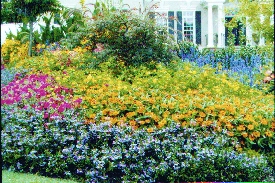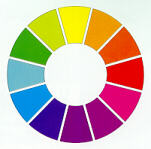 |
When it comes to flower garden design,
it's mostly up to you. Sure, it's
important to do a good job of soil
preparation and carefully match plants
to the site. If you ignore these imperatives,
your results will likely be disappointing.
|
The
aesthetics, however, are more a matter
of personal preference. You might prefer
a formal look with straight edged beds
and plants in orderly patterns. Or you
might prefer a more natural look with
sweeping curves and irregular clumps of
plants. The shapes and styles you choose
are up to you.
The
tips below avoid as much as possible the
prescriptive "shoulds" that
dominate advice about flowerbed design.
Instead, they'll point out the aesthetic
consequences of different strategies.
Remember that, in most cases, there is
more than one way to arrange plants in
the flower bed, and that many of the "rules"
of design were made to be broken. What's
important is that your annual flowerbeds
look and feel good to you.
Annual
Flowerbed Combination Ideas For:
Sun
I Shade
Match
plants to the sun
Break this rule at your own peril. Different
annual bedding plants need different amounts
of light. Most candidates for annual flowerbeds
prefer full sun (6 or more hours of direct
sun each day). Others require shade or
afternoon shade. See Annuals
For Sun and Annuals
for Shade
Pay
attention to soil needs
This is the other unbreakable rule. Most
annual bedding plants need well-drained
soil. To achieve these conditions prepare
your beds properly in advance of planting.
Clay soil tends to to be moisture retentive
so we always suggest preparing raised
or mounded beds to most successfully grow
your annual flowers. Raised beds are easy
to make and once done make planting an
ease. See How
To Prepare an Annual Flower Bed
Where
to plant annual flower beds?
Plant flower beds where you can see them.
Especially consider the views from private
outdoor spaces such as patios, decks,
and terraces. Don't forget about how the
beds will look if they will be viewed
through windows from inside the house.
Also consider how neighbors and passersby
will see them. We often plant annual flowerbeds
near entryways, around mailboxes, along
walkways or paths, or aside decks, patios,
porches or other sitting areas where they
will be enjoyed while relaxing outdoors.
What
shape?
The beds in formal gardens usually have
straight edges. But some gardeners find
these dull. Gently curving edges and shapes
provide a less formal and more relaxed
look.
Edging
When making
a new flowerbed use a garden hose
or orange spray paint to mark the edge
of your bed before you build it. Plan
to maintain the boundary of the flowerbed
by trenching along the painted line or
inside edge of the garden hose with a
shovel. You can also work a variety of
edging materials into your plan, including
products made from metal or plastic, bricks,
field stones, or pavers. See All
About Edging & Borders.
Color
Combinations
With a wide selection of annual flower
colors available, you can change your
color scheme from year to year. To create
visually appealing and alluring gardens
you must effectively combine colors. The
distinction between warm and cool colors
is important to the gardener for several
reasons.
 |
A
color wheel is a diagramatic way
of showing relationships between
colors. Colors on the right side
of the wheel are warm. Colors on
the left side are cool. Colors adjacent
to one another are analogous. Opposite
colors are complementary.
What
is important to gardeners, is how
colors clash with or complement
one another and the distinction
between warm and cool colors.
|
Tips
for selecting your color combinations:
- Cool colors are good for close up viewing
and warm colors are good for more dramatic
displays in your garden even when viewed
from a distance.
- Planting warm colored annuals around
a warm area will make it seem even hotter.
However, if you plant with plenty of cool
green, blue, violet, and pastel colors,
the area won't actually be any cooler,
but it will seem so and be a more inviting
place.
- Be careful of cool and warm color combinations.
If your garden is primarily cool colored,
a mass of flame orange zinnias in the
background would divert attention from
the more subtle colors in the foreground
and disrupt the harmonious effect.
Foliage
and form
Spectacular blooms grab our attention,
but don't ignore the foliage plants. Many
plants, such as the seemingly endless
varieties of Sun Coleus, display outstanding
foliage colors and textures.
Plants
also come in a variety of shapes (also
called form or habit). Some plants such
as verbenas and purslne grow into cushions,
mounds, or mats while others such as purple
fountain grass and salvias are upright
and spiky, providing vertical accents
in the bed. Still others such as begonias
and geraniums are round and bushy.
Arrangement
In formal flowerbeds, plants are usually
arranged in vertical, horizontal, or diagonal
rows, or other regular patterns. In informal
gardens, they can be in clumps (a circular
group of three or more plants) or drifts
(an elongated grouping of plants). Clumps
and drifts are most often planted with
an odd number of the same kind of plant
to give the appearance of a more natural
grouping. In the most informal flowerbed
many varieties of plants are used as specimens
(1 of each) to fill the bed, creating
a cottage garden effect.
Specialty
or theme flowerbeds
You may decide to create a certain theme
for a flowerbed. For example, a moon garden
might consist of only plants with white
flowers or plants with white to light
grey foliage. Other themes of particular
interest might be growing plants that
attract butterflies or hummingbirds. A
foliage bed would consist of plants such
as grasses, sun coleus, or licorice plants,
all known for their outstanding or unique
foliage characteristics.
Combination
Ideas For Spring
Flower Beds,
.Select
from a category below to see combination
ideas for annual flowerbeds in our area
(Zone 8).
Sun
I Shade
_______________________________________
Combination
Ideas For Fall Flower Beds
Coming
Soon
|